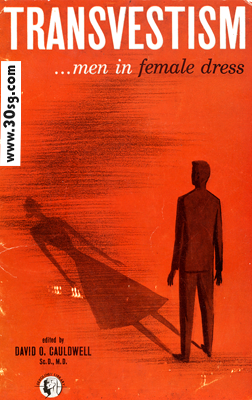
Sometime in 1956 I dropped in at a bargain book store on New York’s 42nd Street, and among other temptations came across a small volume entitled Transvestismen: Men in female dress. Two years earlier, at age fourteen, I had discovered the soothing pleasure of cross dressing, and the book spoke to me personally. I hurriedly stuck it between several other purchases and sheepishly proceeded to the checkout counter. The clerk never flinched—they’ve seen it all on 42nd Street. Back home I discovered that this little 128-page miscellany, mostly articles culled from the pages of Sexology magazine, was “the first major book wholly devoted to the subject”—in English at least. And I began to learn a thing or two.

First of all I learned that what I had been doing by instinct had a name, one that had been coined by Magnus Hirschfeld in 1910, referring to cross dressing under emotional pressure or compulsion.
Secondly I learned that the experts had very different opinions about what this compulsion was all about. Most seemed convinced by Hirschfeld that it was distinct from homosexuality, but as long as “gender” was still a concept confined to the study of languages, transvestism remained a “sexual anomaly,” and easily acquired the implication of some sort of perversion. Some psychiatrists continued to drag their feet, arguing that it was simply “a homosexual illness,” especially when deeply repressed and thus completely invisible (so much for empirical science). Still others argued like Alfred Kinsey that it was a personality disorder, a “warped urge” or “a form of learned sexual behavior,” like fetishism. Particularly insistent was the worry that, if “instilled by the wishes and determination of the mother,” it could “cause a deviation from the accepted norm.” Only the venerable Harry Benjamin spoke up for a possible “chromosomal sex disturbance” in the case of transsexuals, while the caption to a photo of George (“Christine”) Jorgensen spoke of “the delusion that he [sic] is really a female with faulty sex organs.” Benjamin also noted a contrast with the female transvestite, who “being legally immune, finds it easier to identify herself with the male sex, acting the part of the man in appearance as well as in conduct.”
The redeeming grace of the volume is that it was accompanied by eleven autobiographical case histories, all of them male. Their stories had a ring of familiarity, surrounded by an aura of quiet desperation at being confined to the closet. One of them wished she could “meet with others who feel as I do, discuss our problems intelligently, and try to impress society with our problem so that we will not be looked upon as ‘queers’.” Peer support groups and newsletters were still a thing of the future, to say nothing of activism, and stepping out in drag was at best a lone endeavor, fraught with considerable risk, including “the right of the law” to pick them up off the street. There was no compulsion among these middle-class transvestites to join the street “trannies” like those who were to start the Stonewall riot years later.
From these eleven I learned that although I was not alone, I was to remain lonely, confined symbolically enough to my darkroom, where I could latch the door and not be exposed even by accident. I knew I could not come out, which might involve the “help” of a psychiatrist and a mental institution, where shock therapy was an established practice. I learned that psychiatrists, in spite of their theories, understood this compulsion no better than I did, and that we who suffered from it were certainly as sane as any of them, and in better touch with reality. At least we never suffered from the compulsion to conform to normality that reached epidemic proportions in the fifties.
Finally I learned to turn my initial shame into careful caution, the cost of hiding my compulsion—and my true self—from the rigid gender dichotomy dictated by the times.
My, how attitudes have changed in the short span of sixty years—with the notable exception of patriarchal attitudes toward even the slightest hint of “effeminate” behavior in men. These sexist attitudes have seemed to be easing somewhat from time to time, only to become retrenched again, as the recent elections have demonstrated.

